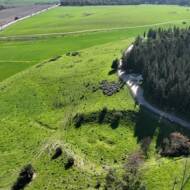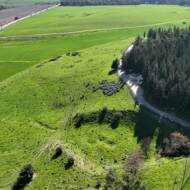
OFF THE BEATEN TRACK: Top 10 Archaeological Discoveries in Israel in 2022 (Part 2)

Many of last year’s incredible finds revolutionized our understanding of Israel’s rich past (including the Biblical era).
By Nosson Shulman
In part 1, we saw 5 of the top 10 archeological finds of 2022. We continue with the next top five incredible discoveries on the list.
6) 15 Silver Maccabean coins minted in the years leading up to the (ultimately) successful Maccabean Jewish revolt against the Greek overlords.
This coin (minted just before the war) shows the face of Egyptian ruler Ptolemy VI, who ruled at the same time that his uncle, Antiochus IV (the villain in the Chanukah story) ruled the Seleucid Empire, which included the land of Israel. Credit: Israel Antiquities Authority (Shai HaLevi )
Every year for 8 days, Jews around the world celebrate the festival of Chanukah. The holiday commemorates the miraculous recapture and rededication of the Second Temple (circa 167 BCE) which had been desecrated by the occupying Hellenistic Greeks, and the subsequent lighting of the Menorah (with only enough oil to last one day) which remained alight for 8 days! This gave the Jews enough time to reproduce the pure olive oil required for the nightly service. The Jews were led by a small band of pious brothers (all priests) known as the Maccabees (aka the Hasmoneans) who, with G-d’s help, were able to overthrow the Greeks (who tried to outlaw Torah observance) and ultimately expel them from the land. While there is much archeology from that war, for the first time ever, remains from the very beginning of the rebellion have been located in the Judean Desert.
In 2022 archeologists exploring inside a cave within the Nachal Dara gorge found a wooden box, containing 15 coins dating from 176 BCE to 170 BCE, just before the rebellion. How did they get there? Luckily, the Book of the Maccabees fills us in.
The rebellion started in 167 BCE (soon after the coins had been minted) with the priest Mattathias (father of the Maccabean band of brothers) killing the King’s official (who tried to get Jews to offer sacrifices to idols) and destroying the foreign altar in Modiin. He then cried out “Let every one who is zealous for the law and supports the covenant come out with me!” Many people fled, including those who went to the Wilderness (the nearby Judean Desert). According to the text, “At that time many who were seeking righteousness and justice went down to the wilderness to live there, they, their sons, their wives, and their livestock, because troubles pressed heavily upon them. And it was reported to the king’s officers and to the troops in Jerusalem the city of David that those who had rejected the king’s command had gone down to the hiding places in the wilderness. Many pursued them and overtook them; they encamped opposite them and prepared for battle against them on the Sabbath day. They said to them, “Enough of this! Come out and do what the king commands, and you will live.” But they said, “We will not come out, nor will we do what the king commands and so profane the Sabbath day.” Then the enemy quickly attacked them. But they did not answer them or hurl a stone at them or block up their hiding places, for they said, “Let us all die in our innocence; heaven and earth testify for us that you are killing us unjustly.” So they attacked them on the Sabbath, and they died, with their wives and children and livestock, to the number of a thousand persons (1 Maccabees 2: 29-38).”
Archeologists believe that the coins belonged to one of the people who had fled to the desert, taking his money with him for safe keeping. Ultimately whoever hid them there was killed in battle, never to return. This is why approximately 2200 years later the coins were still inside the cave, waiting to be found.
7) The Ishmail Papyrus: A 2700 year old papyrus letter with Hebrew writing on it (one of only three known to exist)
This first Temple treasure was discovered in the US, due to a sophisticated intelligence operation. Credit: Israel Antiquities Authority (Shai HaLevi ).
One of the most important ancient Israel discoveries made in 2022 was in ….. Montana!? Yes, you read that right, it was indeed discovered in the western United States. The written text (in ancient Hebrew letters) states “To Ishmael, send….”, with the rest being cut off. A smattering of other sentences also cut off were found on it including “Don’t send”, “Cry after him” and “of no help”. It was written during the end of the Judean Monarchy (it is believed that during that time period all official documents were written on Papyrus) just before the destruction of the First Temple.
Who is the “Ishmael” mentioned in this official document? It was quite a common name at that time. The first recorded person to have that name was Abraham’s first son Ishmael (although this text is almost certainly not connected to him). It could very well be referring to “Ishmael the son of Nethaniah” (see Jeremiah 41) who was of royal descent. He assassinated Gedaliah, the very righteous governor appointed by the Babylonian King to lead the remnant of Jews still allowed to live in the land (the Temple had been destroyed and the Jewish elite had been already exiled to Babylonia). After his assassination, the Jewish people remaining in Israel fled to Egypt (against the advice of Jeremiah), and the first exile was complete. The time period when it was dated certainly makes it a possibility that it is the same person mentioned in the Bible (indeed, archeology directly connected to him have been discovered in excavations elsewhere).
How did such a rare treasure end up in the mid-western United States? An American woman visiting the Rockefeller Museum in East Jerusalem in 1965 (when it was under Jordanian control) was gifted the item by the curator of the museum. Upon returning home, she framed and put it on her wall, and the item was long forgotten about. In 2018 after the death of a top archeologist, his successor was going through his items and discovered a picture of the letter. With some serious detective work, including involving government agencies, they located the scroll (which was on her son’s wall). In order to persuade the man (who chose to remain anonymous) to return it to Israel, they explained that the item could best be studied and then displayed in a temperature-controlled environment. In memory of his mother and because of his pro-Israel, Christian values, he donated it to Israel where it remains today.
8) One of a kind inscription from the time of the righteous King Hezekiah, praising his deeds and paralleling a specific verse from the Bible
This ancient limestone slab, which mentions the biblical King Hezekiah, was discovered in the City of David. Photo Credit: Elad foundation (Vladimir Neichin)
During digs of Jerusalem’s City of David in 2007, a limestone slab with ancient Hebrew writing was found. After years of research, the text was finally deciphered in late 2022 and found to not only have the name of righteous Judean King Hezekiah, but also parallels a Biblical verse.
This is not the first time that contemporary inscriptions referencing King Hezekiah, one of the most prominent and famous Kings of the Davidic monarchy, have been located. The Bible relates that during his reign, the ever expanding Assyrian army laid siege to Jerusalem, and Hezekiah prayed to G-d to intervene. G-d responded by destroying the mighty Assyrian army (for more on that monumental event, click here). When the Assyrian King wrote his annals explaining his loss, he mentioned Hezekiah (for more on that, click here). Additionally, clay seals have been found that refer to the righteous king, and in Iraq a prism mentioning his son was unearthed. Many ruins from his time have also been found at Biblical sites throughout Israel (he was known to be a formidable builder). A contemporary monumental Stele (an inscription where the King was praised for his work) however, had never been found in Israel until now! This is unlike the Kings of Assyria, Babylon and Egypt who were known to be very boastful about their achievements, writing monumental inscriptions praising themselves.
Although the slab contains two broken lines of text, the two most prominent words written are “Hezekiah” and “Pool” (the inscription was found by the remains of a pool close to the one he built near the Gihon Spring. For more on that site, click here). The professors and archeologists involved in its deciphering concluded that the full text was “Hezekiah made the pool in Jerusalem”. This is parallel to the Biblical verse “And the rest of the events of Hezekiah and all his mighty deeds, and how he made the conduit and the pool, and he brought the water into the city, they are written in the book of the chronicles of the kings of Judah. (2 Kings 20: 20).”
9) Four lead ingots from the times of the Biblical Judges. Trading of them is referenced in the Bible.
As related in the Bible, the tribes of Asher and Dan were involved in the international Mediterranean metal trade. Recent discoveries of lead ingots prove how extensive this trading network was. Credit: Hebrew University
One of the best places to discover archeology is underwater, especially at the site of an ancient port. Since such sites would have been host to many shipwrecks (and because the ships carried many precious goods and cargo, the findings go a long way in helping us to understand the past). In Israel, underwater searches at the ancient ruins of Caeserea (the largest man-made port of the ancient world) regularly turn up a treasure trove of finds from all different time periods. In 2022, the 3200-year-old lead ingots found there were analyzed and found to have been mined in Sardinia, an Italian island in the Western Mediterranean Sea, about 1748 miles from Israel. The raw material was then processed on the Island of Cyprus (as illustrated by the stamp from that Island). Cyprus itself was very rich in copper, important in the production of bronze. These metals were subsequently sold all over the Mediterranean including along the coast of Israel, illustrating the vast trading network that existed at the time of the Judges.
“Academics” seem to be surprised by this (together with an even older shipwreck discovered off the coast of Haifa, found to contain tin metal imported from faraway England). To readers of Tanach (Hebrew Bible) however, this long-distance trading of metals comes as no surprise! In Judges 5:19, the verse says “Dan, why does he gather into the ships? Asher dwelt at the shore of the seas, and by his breaches.” The Hebrew word used for “ships” usually means those designed as long distance vessels (England, Cyprus and Sardinia certainly qualify), while the word for “breaches” can also be translated as “harbors (possibly as an example, Haifa, Caeserea, etc). In Deuteronomy 33:25, Moses blessed the (soon to be) coastal tribe of Asher (who had important harbors) saying “Your locks are iron and copper”. In other words, Asher who dwelt in the harbors (as referenced in Judges) traded in metals like copper (such as those mined in Cyprus) which when combined with tin (such as that which was imported to Israel from England thousands of years ago) turned into bronze, a very important metal in Biblical times.
10) First Roman military amphitheater (for gladiator fights) ever found in the Levant (i.e. Southern Turkey, Lebanon, Israel, Jordan, Cyprus and Syria).
The bowl-shaped depression of a Roman military amphitheater found at Legio (in Biblical times, it was famously called Megiddo). Such finds are exceedingly rare in the Roman empire, and virtually non-existent in the eastern half of the empire. Credit: Jezreel Valley Regional Project
From the 3rd century CE and onwards, watching Gladiator fights was a popular pastime in the Roman empire. In Israel even with centuries of digging throughout the land, only 4 Amphitheaters have ever been found, including Beit Shean (for more on that site, click here), Caeserea, Beit Guvrin (for more on that site and for pictures of its amphitheater, click here) and Samaria. However, they were all for civilian use. Ones built solely for the usage of military personnel had not only never been found in Israel, but never in the entire Eastern half of the gigantic Roman empire. Even in the western regions of the empire where some were located in Germany, France, and Spain, they are still rare. This is why the 2022 identification of a military amphitheater outside the ruins of the Biblical city of Megiddo (which the Romans called “Legio”) is so significant. It was probably built during the reign of the Roman Emperor Diocletian who ruled from 284 to 306 CE. The Emperor (one of the most capable rulers in Roman history) was a great builder, and many of his projects in Israel can still be seen today (indeed a still shiny gold coin with his face, minted in 294 CE, was found here).
The amphitheater was used for both the training and entertaining of the troops of the 6th legion who were stationed in Legio.
Nosson Shulman is a licensed tour guide and trip organizer in Israel who specializes in History, Tanach (Bible) and Adventure Tours. For more itineraries click here. Check out our new Virtual tours including free sneak preview videos.
Bring Purim Joy to Israeli Victims of Terror!
Join us in providing Israeli victims of terror and Jewish refugees from Ukraine – who have suffered terribly – with much needed comfort, blessing and holiday joy.
Families have been destroyed by ongoing terror attacks. Orphans have been rescued to Israel from brutal bombings in Ukraine. They need our compassion and love!
Brighten their holiday by sending beautiful Purim food baskets, yummy treats, personal notes and amazing toys for the children.
CLICK HERE TO SEND YOUR PURIM GIFT & PERSONAL NOTE TO THE VICTIMS
The post OFF THE BEATEN TRACK: Top 10 Archaeological Discoveries in Israel in 2022 (Part 2) first appeared on United with Israel.
United with Israel
